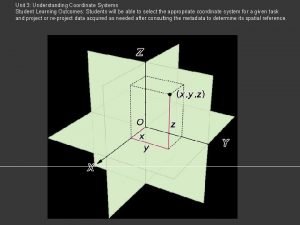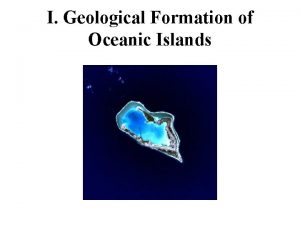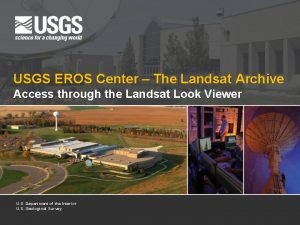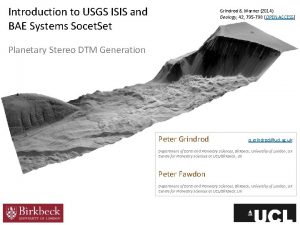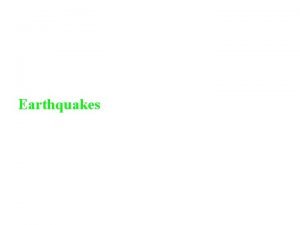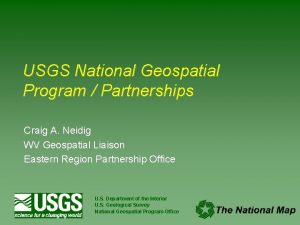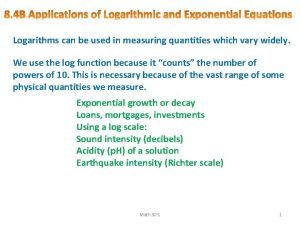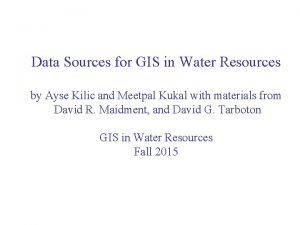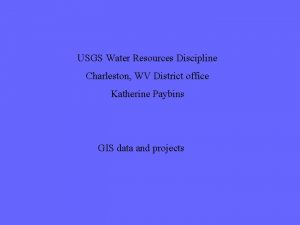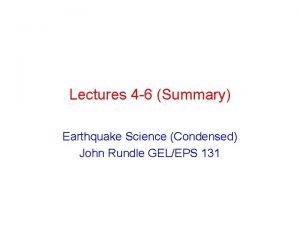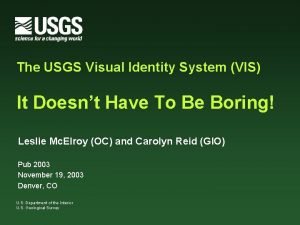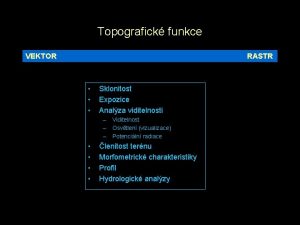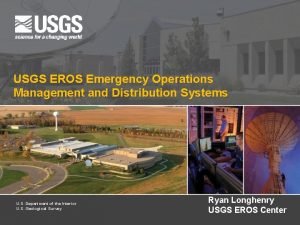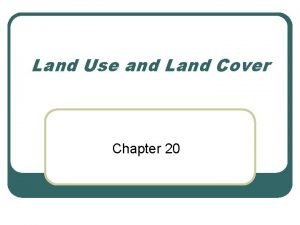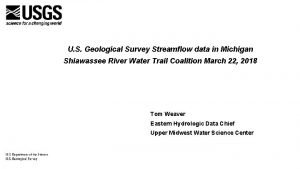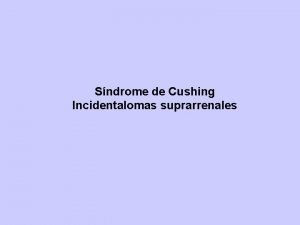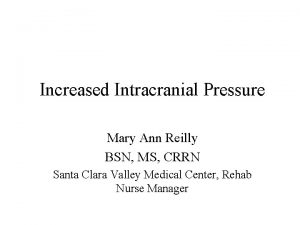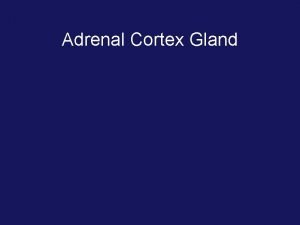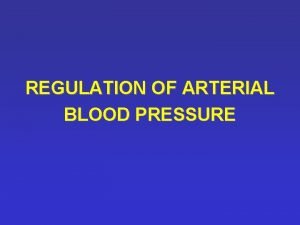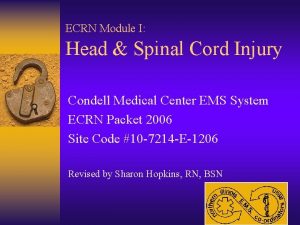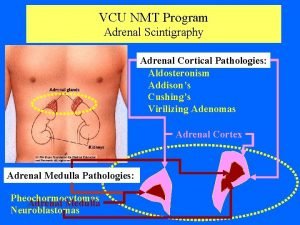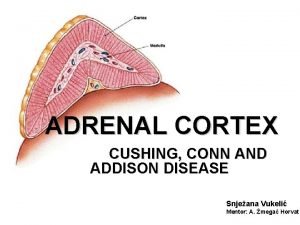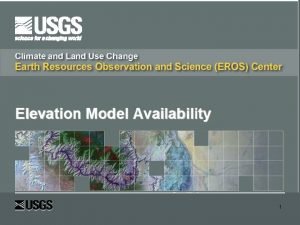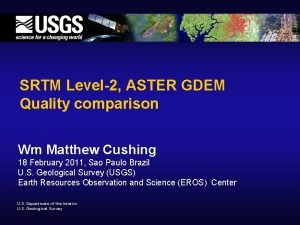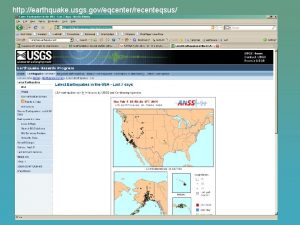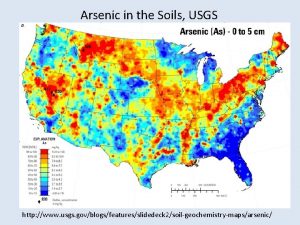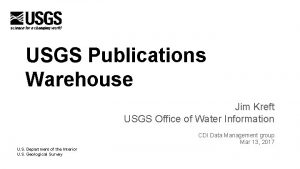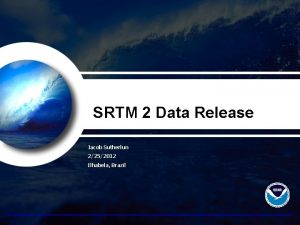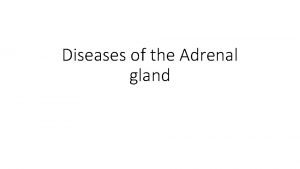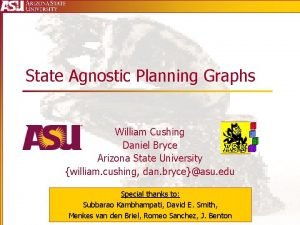SRTM 30 m Wm Matthew Cushing USGS 16




















































- Slides: 52

SRTM 30 -m Wm Matthew Cushing (USGS) 16 May 2013 U. S. Department of the Interior U. S. Geological Survey

SRTM Mission Shuttle Radar Topography Mission (SRTM) Space Shuttle Endeavour during the 11 -day STS-99 mission in February 2000 Used a technique known as Interferometric Synthetic Aperture Radar to generate a DEM at a near global extent of 56° S to 60° N 2

• STS-99 acquired topographic (elevation) data usingle-pass interferometry to capture two radar datasets simultaneously via two antennas with slightly different angles. • The main antenna was located in the shuttle’s cargo bay, while the other was located at the end of a 60 -meter (200 -foot) mast extended from the cargo bay once the shuttle was in space. • National Aeronautics and Space Administration (NASA) and the National Geospatial-Intelligence Agency (NGA) participated in an international project to acquire radar data, which were used to create the first near-global set of land elevations. 3

• SRTM surface elevation above, at, or below sea level (in meters) was then calculated from the difference between the two signals. • These data were used to construct a global digital elevation model having elevation postings every 1 arc-second (approximately 30 meters)1. • Until a recent policy change, SRTM elevation data outside of the United States were distributed at 3 arc-second postings (approximately 90 meters). The recent policy change permits the unrestricted distribution of 1 arcsecond elevation data outside of the US, which are being released on a region-by-region basis. 4

SRTM Mission SRTM near global coverage 60 o 56 o Source: JPL 5

SRTM Mission SRTM main antennas and mast Source: JPL 83 m Source: JPL 6

SRTM – side-looking radar technique Source: JPL 7

SRTM – side-looking radar technique 8

SRTM Data Characteristics SRTM data characteristics to consider prior to including the DEM in data analysis. Data voids Phase noise Canopy bias Horizontal resolution 9

Data Voids Shaded Relief of DTED 1 SRTM with gaps (Voids) (Grohman, 2006) 10

Data Voids Side looking radar technique results in void pixels in high relief areas Source; http: //www. opendem. info/srtm_processing. html 11

Feathering Method (Grohman, 2006) The feather method uses a fill source pixel at the same geographic area without adjusting for the difference in elevation (delta) and then “feathers” the edges between the different data sources to mitigate the difference in elevation. 12

Delta Surface Fill (Grohman, 2006) 13

Phase Noise An example of phase noise from two different surface types. A is from a rock outcropping, and B is bare soil with sparse vegetation 14

Canopy Bias Shaded Relief / Landsat image mosaic illustrating canopy bias along the borders of a protected forest in Ghana, West Africa. 15

Canopy Bias Example of potential false channel extraction using SRTM data. 16

Horizontal Resolution Original data collection was near 30 m. Increased usability and smoothing algorithm was applied reducing resolution to 45 and 60 meters (Farr, 2006). Other studies show the resolution may be between 30 and 48 meters (Pierce, 2006). 17

Slope Overestimates in areas of steep topography Overestimates in areas of little relief (Guth, 2006; Jarvis, 2004; Farr, 2006) There is a combined influence of the smoothing algorithm and the phase noise error (Farr, 2006) 18

Overall SRTM Data Quality The SRTM is an unprecedented collection of the world's topography and currently there is no global dataset that can match its versatility and quality (Guth, 2006). 19

20

21

22

23

24

25

26

27

ASTER GDEM 30 m ASTER GDEM version 2 V 2 used 1, 500, 000 stereo pairs – released 30 m ASTER GDEM version 3 V 3 uses additional 500, 000 stereo pairs – release pending 2015 Planet. DEM 30 (GDEM v 2 source) 28

ASTER Global DEM Coverage/cell size/Availability Accuracy 83 degrees south to 83 degrees north/1 -arcseconds (30 meters)/ V 2. 0 released (V 3. 0 release 2015) Vertical error (LE 95): absolute 17 m Horizontal error: absolute 0. 6 pixel; Source data SRTM V 1. 0 Digital Elevation Model Data ASTER GDEM 2 (Global Digital Elevation Model Version 2) National Elevation Dataset (NED) USGS GMTED 2010 Costs none Use/distribution restrictions Citations Tetsushi, Manabu Kaku, Akira Iwasaki, Dean Gesch, Michael Oimoen, Zheng Zhang, Jeffrey Danielson, users must agree to redistribute data products only to individuals within their organizations or projects of intended use, or in response to disasters in support of the GEO Disaster Theme. When presenting or publishing ASTER GDEM data, users are required to include a citation stating, "ASTER GDEM is a product of METI and NASA. ” Tabatha Krieger, Bill Curtis, Jeff Haase, Michael Abrams, Robert Crippen, and Claudia Carabajal, 2011, ASTER Gobal Digital Elevation Model Version 2 – Summary of Validation Results, available at https: //www. jspacesystems. or. jp/ersdac/GDEM/ver 2 Validation/Summary_GDEM 2_validation_report_final. pdf 29

30

31

32

33

34

35

36

37

38

39

Global Land Survey 2000 DEM Coverage/cell size/availability Vertical accuracy: ? Source data Costs Use/distribution Citations Global/3 arc-seconds (90 meters)/released NGA’s SRTM V 1. 0 Digital Elevation Model Data National Elevation Dataset (NED) Non-SRTM DTED Canadian Digital Elevation Data (CDED) GTOPO 30 none Ambiguous restrictions – currently not redistributed 40

NASADEM Coverage/cell size/availability Accuracy Source data Costs Use/distribution restrictions Citations Global/1 -arcsecond (30 meters)/release estimated 2017 NASA SRTM Digital Elevation Model Data at full resolution NASA ICESat/Geoscience Laser Altimeter (GLAS) surface elevation measurements ASTER Global DEM (GDEM) version 2. 0 National Elevation Dataset (NED) for US and Mexico produced by USGS GMTED 2010 developed by USGS and NGA Canadian Digital Elevation Data produced by Natural Resources Canada none 30 -meter data will be distributable NASA, n. d. , NASADEM: Creating a New NASA Digital Elevation Model and Associated Products, available at https: //earthdata. nasa. gov/our-community/community-data-systemprograms/measures-projects/nasadem-nasa-digital-elevation-model 41

Planet. DEM Coverage/cell size/availability Accuracy Source data 90 meter Global/3 -arcsecond (90 meters)/released 83 north to 83 south/1 -arcsecond (30 meters)/released Vertical (LE 95): 14 meters (90 m); 20 meters (20 m) Horizontal (CE 95): 10 meters; 30 meters (30 m) SRTM V 4. 1? Digital Elevation Model Data Antarctica NSIDC at 200 m Alaska Geospatial Data Clearinghouse Canada CDED National maps and GDEM v 2. 0 Corrected with national maps GDEM and NED Source data 30 meter Costs Use/distribution restrictions Citations ASTER GDEM v 2. 0 Planet. DEM 90 to correct anomalies and artifacts Commercial product 30 -meter data is not redistributable - only granted rights to use the PRODUCT 90 -meter data is not redistributable - only granted rights to use the PRODUCT Planet Observer, 2014, Technical sheet Planet. DEM 30, available at www. planetobserver. com Planet Observer, 2014, Technical sheet Planet. DEM 90, available at www. planetobserver. com 42

Tan. DEM-X/Terra. SAR World. DEM Coverage/cell size/available Accuracy Vertical error (LE 90): 10 m absolute; relative (< 20% 2 m; >20% 4 m) Horizontal error (CE 90): 10 m absolute Global/12 meters/released in part Source data Tan. DEM-X Terra. SAR Costs Science Tan. DEM-X DEM – 0. 4 arc-second (12 m); 1 arc-second (30 m); 3 arc-second (90 m) Commercial World. DEM - 0. 4 arc-second (12 m) Use/distribution restrictions Restricted use product, which cannot be transferred or disclosed Citations Tan. DEM-X DEM Product Specification available at https: //tandemx-science. dlr. de World. DEM available at http: //www. astrium-geo. com/worlddem/ 43

SPOT Elevation 30 Coverage/cell size/available Accuracy Vertical error (LE 90): 10 -30 m Horizontal error (CE 90): 10 -16 m Source data SPOT 5 HRS SRTM DEM fill Costs Commercial product Use/distribution restrictions Restricted use product, which cannot be transferred or disclosed Citations Elevation 30 Technical Information, available at http: //www. astrium-geo. com/en/198 -elevation 30 Astrium, 2005, SPOT DEM Product Description Version 1. 2, available at http: //www 2. astrium- global/1 -arcseconds (30 meters)/released in part geo. com/files/pmedia/public/r 467_9_spot_dem_product_description. pdf Astrium, 2006, SPOT DEM Precision Product Description Version 1. 0, available at http: //www 2. astriumgeo. com/files/pmedia/public/r 468_9_spot_dem_precision_product_description. pdf Astrium, 2011, Reference 3 D Product Description Version 6. 1, available at http: //www 2. astriumgeo. com/files/pmedia/public/r 469_9_reference 3 d_product_description_201105. pdf 44

ALOS World 3 D Coverage/cell size/available Accuracy Source data Costs Use/distribution restrictions Citations global/1 -arcseconds/30 meters/after March 2016 Vertical accuracy: 5 m Horizontal precision: 5 m ALOS-2 PRISM 30 -meter product free of charge unknown Precise Global Digital 3 D Map "ALOS World 3 D" Homepage, 2014, available at http: //www. eorc. jaxa. jp/ALOS/en/aw 3 d/index_e. htm 45

46

… until now! 47

48

SRTM NGA SRTM void filled 90 meter released 30 meter released SRTM Plus (version 3) (2013) 90 meter released 30 meter released Planet. DEM (SRTM v 4? source) 90 meter released NASADEM (reprocess SRTM source) 30 meter release date 2017 49

SRTM 50

NGA SRTM Digital Terrain Elevation Data Coverage/cell size/availability Global/3 -arcseconds (90 meters)/released Global/1 -arcseconds (30 meters)/phased release pending Vertical accuracy: 26 -30 meters RMSE Source data SRTM V 1. 0 Digital Elevation Model Data SPOT 5 Reference 3 D National Elevation Data (NED) GEODATA 9 second digital elevation model (DEM) for Australia Antarctica satellite radar and laser altimeter DEM Greenland satellite radar altimeter DEM GTOPO 30 Costs none Use/distribution restrictions 30 -meter data is not distributable 90 -meter data ? Citations Grohman, G. Kroenung, and J. Strebeck, 2006, Filling SRTM voids: The Delta Surface Fill Method. Photogrammetric Engineering and Remote Sensing, v. 72, no. 3, p. 213 -216. Slater, J. A. , G. Garvey, C. Johnston, M. Haase, B. Heady, G. Kroenung, and J. Little (2006), The SRTM data ‘finishing’ process and products, Photogrammetric Engineering and Remote Sensing, v. 72, p 237 -247. 51

NASA SRTM Plus (v 3) DEM Coverage/cell size/availability 56 degrees south to 60 degrees north/3 -arcseconds (90 meters)/released 56 degrees south to 60 degrees north/1 -arcseconds (30 meters)/restricted access Accuracy Vertical error: absolute 16 m; relative 10 m Horizontal error (CE 90): absolute 20 m; relative 15 m Source data SRTM V 1. 0 Digital Elevation Model Data ASTER GDEM 2 (Global Digital Elevation Model Version 2) National Elevation Dataset (NED) USGS GMTED 2010 Costs none Use/distribution restrictions 30 -meter data is being made available in phases from 2014 -2015 90 -meter data available with no restrictions at https: //lpdaac. usgs. gov/products/measures_products_table Citations LPDAAC, 2014, SRTM Topography: Update Includes NASA Version 3. 0 (SRTM Plus) at https: //lpdaac. usgs. gov/sites/default/files/public/measures/docs/NASA_SRTM_V 3. pdf 52
 Usgs map projections poster
Usgs map projections poster Hawaii 5-0
Hawaii 5-0 Landsat look viewer
Landsat look viewer Isis usgs
Isis usgs Quicktime usgs
Quicktime usgs Usgs
Usgs Usgs
Usgs Http://earthquake.usgs.gov/earthquakes/map/
Http://earthquake.usgs.gov/earthquakes/map/ Usgs core research center
Usgs core research center Usgs.gov
Usgs.gov Usgs chesapeake bay
Usgs chesapeake bay Usgs streamflow wv
Usgs streamflow wv Usgs.gov
Usgs.gov Water data warehouse
Water data warehouse Vis visual identity system
Vis visual identity system Facts on water cycle
Facts on water cycle Webgis adalah
Webgis adalah Usgs sentinel 2
Usgs sentinel 2 Usgs.gov
Usgs.gov Http://earthexplorer.usgs.gov/
Http://earthexplorer.usgs.gov/ Usgs land use classification
Usgs land use classification Usgs streamflow michigan
Usgs streamflow michigan Usgs national hydrography dataset
Usgs national hydrography dataset Cushing school bus
Cushing school bus Papillary thyroid carcinoma gross
Papillary thyroid carcinoma gross Cushing's triad signs
Cushing's triad signs Síndrome de cushing
Síndrome de cushing Pletora facciale cushing
Pletora facciale cushing Cushing's syndrome
Cushing's syndrome Decorticato e decerebrato differenza
Decorticato e decerebrato differenza Intracranial pressure regulation
Intracranial pressure regulation Cushing triad symptoms
Cushing triad symptoms Cushing refleksi
Cushing refleksi Cushing triadı
Cushing triadı Cushing and dolan
Cushing and dolan Oxyphil
Oxyphil Cushing before and after
Cushing before and after Cushing's reflex
Cushing's reflex Cushing triadı
Cushing triadı Sindrome de cushing yatrogeno
Sindrome de cushing yatrogeno Sindrome de cushing yatrogeno
Sindrome de cushing yatrogeno Adrenal bez embriyolojisi
Adrenal bez embriyolojisi Andrew cushing newcastle
Andrew cushing newcastle Cushing and dolan
Cushing and dolan Cushing's support and research foundation
Cushing's support and research foundation Intracranial pressure
Intracranial pressure Cushing's triad
Cushing's triad Adrenal cushing
Adrenal cushing Conn's syndrome
Conn's syndrome Pithed model
Pithed model Oculocardiac reflex pathway
Oculocardiac reflex pathway Cushing's disease before and after photos
Cushing's disease before and after photos Daniele mencarelli
Daniele mencarelli
